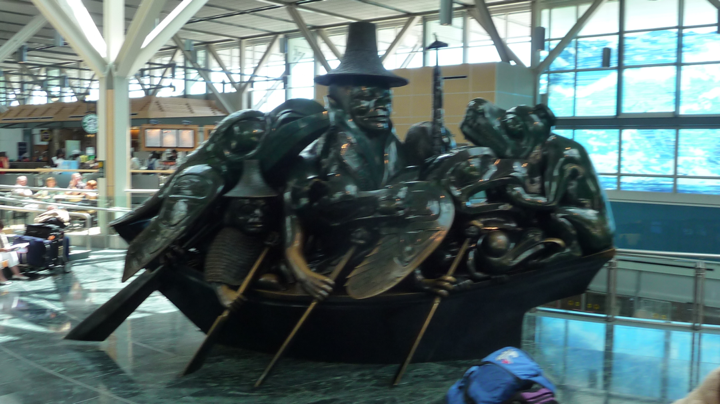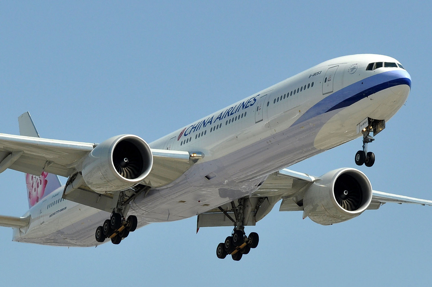Houston - IAH
/New flights power Asian connections through the Energy City
Houston’s historic importance as a center of energy production and logistics quickly put it on the post-World War II map of long-range flights from Europe and Latin America. Companies like Phillips 66, Conoco, Halliburton, and Occidental – and the contractors and suppliers who support them – send their people all over their world, often on short notice: they require frequent international service and are willing to pay well for it.
The city’s seaport and distribution infrastructure – and closeness to Mexico and the Caribbean – also gave it more of a global outlook, cuisine, and population. Yet it was not until after the Vietnam War and the emergence of the Four Tigers economies in the 1970s-80s when Houston started to pick up Asian influences and migration, and vibrant Vietnamese and Taiwanese communities developed in the southwest quarter of the metro area in the 1980s-90s.
Continental 777-200 at Narita Airport, preparing to depart for Houston
It took until 1998 for Houston-headquartered Continental Airlines to start nonstop service to Tokyo, the city’s first air link of any kind to Asia.
United and Continental merged, moving their headquarters to Chicago but keeping Houston as a mega hub. While United has not added any more nonstop flights to East Asia, they have encouraged their Star Alliance partners to come to Houston, so today IAH has daily or near-daily service to:
- Tokyo Narita – on United and also ANA-All Nippon Airways
- Beijing – with Air China
- Taipei – on EVA Air
- Singapore – with Singapore Airlines (this flight stops in Manchester, England on the way)
From these four hub cities, nearly any point in East and Southeast Asia can be reached in just one stop.
Domestically, United covers all major US cities from IAH and regional destinations in Texas, the Southwest, and the Gulf Coast. These areas, and Florida, are best-positioned to use Houston as a connecting point for flights to Asia.
Delta, American, and Spirit also send numerous flights into IAH, but don’t have international partners flying there to take you to Asia via Houston. Finally, Southwest doesn’t fly to IAH at all, as they have a significant base at Hobby Airport on the south side of the city.
Customs Arrival
International arrivals for the Asian carriers pull up to gates in Terminal D, where mid-level walkways and bridges direct passengers through the building, across the street, and into the central Customs checkpoint.
Image of Terminal E courtesy Visit Houston
Passengers arriving on United’s flight dock at Terminal E, where they ascend a level and walk above that concourse to get to the same central Customs area.
Passport checks take place on the upper level, and then passengers go down a floor to the baggage claim and Customs inspection area. For travelers not flying onward, there are exits from this point to the arrivals area on the ground floor of Terminal E. For people connecting to other flights, turn right after Customs for baggage re-check stations and then security screening. Once through TSA screening, you will come out into a corridor linking the D and E gates, with the Skyway train station just around the corner.
Navigating the airport
One thing is certain when flying from or connecting through IAH: there’s almost always going to be a lot of walking.
The airport opened in 1969, before the days of security checks or massive airline hub operations, so the original Terminals A and B were small, separate buildings each with four “banjo” concourses tucked in close. By the early 1980s this arrangement was clearly impossible to manage for Continental’s growing hub, so they built Terminal C further east. Terminal D opened in 1990, then Terminal E in 2002.
In 2018, only two "banjos" remain, on the north side of Terminal B. These will get torn down in the early 2020s and replaced with more-conventional concourses.
The terminals are spread so far apart because they are sitting between the airport’s east-west runways, and concourses can only extend outward by a few airplanes’ wingspans before blocking taxiways. Likewise, creating one central terminal is impossible because of how the roadways and tunnels were laid out in the 1960s. In fact, the airport has run out of room and cannot add any more terminal buildings to the east – so they have been progressively re-constructing the terminals and gate areas to become more efficient. IAH is about halfway through that process, and it will take well into the 2020s for all its parts to be rebuilt.
The C-North gates have breathtaking design with lots of open space - the model for what the B-North and D gates will look like in about ten years...
United’s operation in Houston is so large that it now uses all the B, C, and E gates, and many of the northern A gates as well. Delta, American, Spirit, Air Canada, Alaska, Frontier, and other US and Canadian carriers use gates in the A complex, while all the overseas and Mexican carriers use the D gates.
So even for a United-United connection it is entirely possible you may arrive at gate A1 and depart from gate E19. Thankfully, all gates can be reached without having to leave the secure area.
Skyway shuttle trains run along the north side of the complex, with one station in Terminal A, B, and C, and a station between Terminals D and E. These trains are quick and frequent and afford a pretty good view of the runways and ramp on the north half of the airport. From one end to the other is about a 5-minute ride.
Corridor connecting the E-gate concourses
However, even using the Skyway train, there is still considerable walking needed along the C and E gates. And if you are using United Express service leaving from the B gates (especially B1-B31), those are also a long walk from the Skyway station. For domestic-domestic, or domestic-international connections, we would advise using no less than a full hour and preferably 90 minutes between flights.
The one case where you won’t have too far to walk is if you are being dropped off on the ground floor of Terminal D to check in for your flight – in that case the gates are immediately above the ticket counters and security checkpoint.
Family-friendly amenities and hidden gems
IAH has no children’s play areas and no consistent safe stretches of space where kids can run around to burn off steam while waiting for boarding. Even open gate areas in the C14-C15 or D1-2-3 stretches will see a steady stream of cart traffic and just enough people trying to sleep to keep them “no fly zones” for children.
The international gates east of the small food court, D7 – D12, have several interesting child-height art installations and occasionally someone playing the grand piano.
Over in Terminal A, the Skyway train station is full of eye-catching star sculptures, and the walkway between the north and south gate areas holds many sculptures under Plexiglas at kids’ eye level. There are also musical performances scheduled in the north-side food court. (And here is a link to the full portfolio of artwork)
Mindworks, near gate E9, is a small but well-stocked kids’ shop with toys and aerospace / NASA gear; well worth a visit if you are in the E gates or even the C30-C40 area.
Surprisingly missing is any exhibit from NASA/Johnson Space Center – in contrast to the two locations Kennedy Space Center has in the Orlando terminal. There is plenty of open-air space in the E gates, the C-North gates, and the ticket hall of Terminal D for them to mount full-sized spacecraft replicas!
Restrooms
Just as the gate areas are being progressively torn down and rebuilt, so are the restrooms. The newest parts of the complex (A-gates, E-gates, B1-B31 United Express holdroom, and the C-North gates) have been built with conveniently-located family restrooms.
The C-North / E / new B mens’ and womens’ lavatories also have more stalls and more room in each stall for stowing carry-on bags up off the floor (or for managing children if need be.)
D-gate restroom entrance
The restrooms in the international D-gate areas are adequate in periods of average traffic, but starting to show their age and not up to the same standard as the ones in the E-gates, plus there are no family facilities in that stretch. This could lead to long waits if several flights are leaving around the same time.
Typical stall in the E-gates; note the small shelf above the toilet for storage.
Restroom repair and cleanliness is also uneven across the terminals – the newest are simply built better for the traffic they get, so they are easier to maintain.
Food and Shopping
Thankfully, great food options for any palate or food requirement are available throughout the complex, and since you’ll be walking anyway, you’ll get to see a wide spectrum of choices. The local cuisines of East Texas and the Gulf are well-represented, from steakhouse to Tex-Mex, Cajun/Creole, Vietnamese, and seafood.
National chains are well-represented, and the airport is rolling out many sit-down restaurants that use the popular order-from-iPad service format. There are also several shops to pick up fresh fruit and deli sandwiches.
Shopping options include the usual newsstand, electronics, cosmetics, sunglasses, and luxury-goods choices, but you’ll also find more than the usual number of clothing stores.
IAH is piloting an interesting twist to shopping: certain merchants will let you use your MileagePlus points toward payment!
Connectivity
Wi-Fi is free and strong throughout the airport.
Houston has a metro rail system, but has not extended it out to IAH – it might get there by 2035, according to the latest long-range plan. There is a bus route to downtown, but it does not go near the Convention Center or main bank of hotels. SuperShuttle, taxi, or private car are the only realistic options for fast ground transport.
Lodging
If you need to stay overnight before or after your trip, the Houston Airport Marriott is located between Terminals B and C, and can be reached from any terminal via underground Subway (catch it on level LL below baggage-claim). Many rooms have a good view of the ramp! For its convenient location, it does claim a premium price.
Lower-priced national chain locations with family-friendly amenities and free shuttles to IAH would include the Spring Hill Suites by Marriott, DoubleTree by Hilton, Country Inn & Suites, La Quinta Inn, Hampton Inn, and Courtyard by Marriott.
See also…
Houston George Bush Intercontinental Airport official website










































